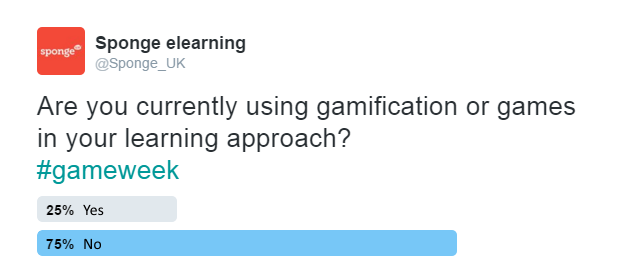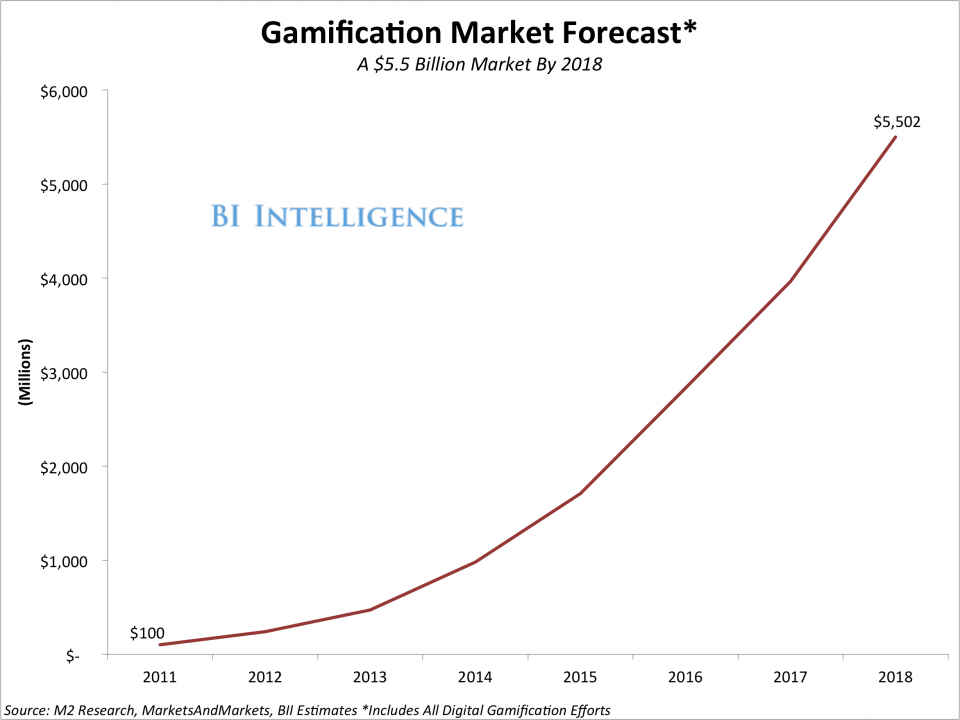5 predictions about gamification in learning

Take a glimpse into the future of elearning gamification with insights from some of the leading experts in the field.
Following the second annual #gameweek, we anticipate which gamification trends will continue and which will change over the next year.
The wave is building
With the amount of coverage on gamification and games, you would think our workplaces are flooded with gamified learning programmes. The #gameweek Twitter poll suggests otherwise.

Research from the Association for Talent Development (ATD) supports the idea that there is still a long way to go. ATD found that only 25% of organisations currently use gamification in learning, and 20% use serious games.
Gamification expert, Professor Karl M. Kapp said: “One good thing about the statistics is that there is a lot of room for opportunity. It is a little difficult sometimes to take the plunge. You may have a conservative corporate culture, face challenges in development or struggle to know what to gamify. So, there is a lot of hesitation about exactly how to get started.”
Learning Game Designer, Jason Butler thinks many L&D teams are still testing the water. “People are thinking about it, taking those first tentative steps or experimenting with gamification. But I think there’s definitely an appetite for it, and I would expect the percentage of usage to increase over the next 12 to 18 months.”
Serious games are going mobile
Mobile is the fastest growing market for games in the UK, up 21.2% from 2014 to 2015.
Compared to the console hardware market, which saw a drop of close to 25% in the same period, mobile is increasingly seen as a way for everyone to enjoy video games.
The learning game industry will need to reflect this development by making games work on a variety of devices. With modern web technology, it’s possible to not only build an elearning course that works on mobile, but to integrate fully featured games into it too.
Jason Butler talks about using a mobile first design philosophy for learning games. “You can make it more instant, people understand it and it’s more tactile, immersive and engaging,” said Butler. “There’s a huge thirst to be able to take your learning away with you in your pocket.”
L&D departments are already asking for this kind of functionality for their Learning Management Systems (LMSs), elearning courses and their serious games.
We predict that more L&D teams will be getting the most out of their elearning games by going for a responsive, multi-device approach.
Gamification grows, L&D needs to stand out
Pete Jenkins, leading gamification consultant has a bright view for gamification in the business as a whole. This could mean a bigger challenge for L&D teams introducing gamified learning.

If the gamification market grows as predicted by Business Insider , it’s going to become a commonplace to see points, badges and leader boards wherever you go.
On one hand, this trend will mean more familiarity with the different aspects of games and gamifications. Stakeholders are more likely to have been exposed to positive gamification experiences.
If getting buy in from your managers becomes easier, getting your learners on board might be harder than ever.
When gamification makes its way into more aspects of work life, your learning games will need to stand out more to offer the same boost in engagement.
Elearning games will become more ambitious and have a broader scope than before.
Elearning strategy games will widen appeal
One of the concerns for L&D departments is making sure game content is inclusive for all learners.
The 45-74 year old age group makes up 27% of UK gamers according to an Internet Advertising Bureau (IAB) report. In their report Avoiding the demographic crunch: Labour supply and the ageing workforce the CIPD highlight that currently over 30% of the workforce are over 50.
Introducing elearning games to a wide age range takes some careful planning. Research by Quantic Foundry shows that strategy style games are the most universally appealing across age groups.
Senior Manager for Learning Solutions at Yorkshire Building Society (YBS) Group Emma Barrow has identified something she calls the ‘grandparent effect’. When older employees are dismissive about a learning game it helps to relate it to a situation they are familiar with.
Emma describes talking to learners who are not initially receptive. “At Christmas you all sit around and play Monopoly or Scrabble, that’s a game, let’s think about it differently,” she urges.
An elearning game doesn’t have to be a jumping, flashing, action-packed experience. Strategy games that tap into the same skills you use when playing Scrabble can introduce new skills to learners just as effectively.
This kind of experience uses game thinking and gets the same benefits that other types of games give without explicitly being called a game.
During a Learning and Skills Group (LSG) webinar, Louise Pasterfield gave this advice: “Using different language can help – set it up as a ‘challenge’ or that you’re going to discover something about yourself, there are ways you can word it so that it doesn't come off as a game”.
Your next elearning game might not look like a game at all. Some of the overtly gamified elements will take a back seat and deeper, more strategic games will start to become more popular for L&D teams with a wider target age range.
More games will be measured
Tracking the results of any elearning course is important. Many of the gamification experts we’ve spoken to have pointed out that elearning games are often not tracked as well as they could be.
Karl Kapp says: “The nice thing about game-based learning is that we can track everything. How long it took a learner to answer a question, how many points they've earned, and by tying the points to learning outcomes, we know if they've got it or not.”
The potential is there to record all the interactions that make up an elearning game. Using this data you can see where the game is working well and which areas you could improve upon.
Combined with more traditional feedback from learners who have played the game it gives you a complete picture of the training experience.
When we asked leading figures in the industry about the big issues for elearning in 2016 there was a lot of talk on learner focus. Laura Overton from Towards Maturity said: “The staff in our organisations are consumers of technology. They are also consumers of learning but they don’t necessarily know it and I think we need to get in tune with our staff.”
Your L&D strategy will continue to be led by learners and more emphasis will be put on measuring success of courses. We predict games and gamification will lead the way in tracking interactions and discovering more effective ways to engage learners.
We’re already looking forward to #gameweek 2017 when we can check back in on our predictions. If you have any experiences of gamified learning you’d like to share, please get in touch on Twitter @Sponge_UK